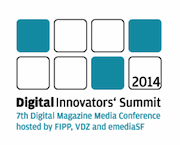The Rise of Wearable Media
Barely a week passes without a new piece of wearable technology either hitting the shelves or beginning its journey in the development lab. From already well-recognised technologies, such as Google Glass, the Sony SmartWatch and Nike’s FuelBand, to lesser-known iterations such as the Qualcomm Toq smartwatch and Nichole Scherzinger’s Twitter dress - displaying fans’ twitter messages in real-time - wearable technology is becoming big business.
A recent infographic in the UK’s Guardian newspaper revealed an estimated 8 million Brits now wear some form a wearable technology, while 82 per cent of wearable tech users in the US believe it enhances their lives. Twenty-seven per cent of UK wearable tech users said it has enhanced their love lives.
View the infographic in full: click here
So what are the opportunities for the media industry when it comes to wearable technologies, and what impact will wearable media have on content?
Professor Retha Hill is executive director of the Digital Innovation and Entrepreneurship Lab at the Walter Cronkite School of Journalism in the US. She says wearable media offers exciting opportunities for content producers – but adds it has some way to go before it reaches its full potential.
“Wearable media is exciting but it feels like people are waiting to see how it shakes out,” she says. “Even with the more advanced forms, such as Google Glass, it still feels a bit cumbersome and I’m not sure people have been overwhelmed by it.
“One of the things stopping from investing heavily in it is that it’s an expensive risk. I think companies look at things like Second Life - how quickly that came and went because the public didn’t follow - and they worry wearable media could go down the same route.”
John Winsor, CEO at creative ad agency Victors & Spoils, concurs. “Wearable media is certainly one of the big innovations to watch. But my concern is that there is too much media now,” he says. “I think there is a counter-trend developing to avoid media altogether because consumers are being bombarded from all angles.”
However, Hill adds that any device which enables you to engage an audience provides great content opportunities: “Even if those devices were not originally created for content, such as gaming devices or Nike’s FuelBand, there is great value in the fact consumers have chosen to have them and are actively using them.”
Moving into the mainstream
Ruth Papazian is a US-based journalist currently using Google Glass to create a documentary depicting modern life in the Bronx. She says wearable media can have a big impact on journalism and content creation going forward.
“Journalism is a multimedia profession now,” she says. “With our ability to report news instantly and through social channels, audiences have come to expect photographic evidence and supporting images. Wearable media can certainly help. As a journalist, I appreciate having different ways to tell a story.
“Another opportunity lies around transparency and accountability. Wearable media can help our profession repair some of the damage done to it over a lack of accuracy and people being quoted out of context, because it allows you to gather so much raw material.”
Speaking of her own documentary project, Papazian adds that wearable media also offers a number of practical benefits.
“It adds spontaneity,” she says. “I can take a picture in many different ways or start filming in an instant – without having to reach for a camera and losing the moment. It allows me to get very close to a subject without sticking a huge news camera in his or her face. People freeze up when there is a big news camera there.”
Cronkite’s Hill agrees there’s a big appeal around the usability aspects.
“I once created an augmented reality app, which gave visitors information about the local town as they moved around it,” she explains. “Using the viewfinder of your smartphone to receive that information is cumbersome and it can be dangerous too. Wearable media makes those processes much easier.”

Tailoring content
Hill adds that, while content creators will have to carefully consider how they generate content for wearable media devices, they already have a strong understanding of the type of content required.
“In the past few years we have become adept at creating content in short-form. Twitter, Facebook and video have taught us how to engage quickly and effectively with audiences. That is how content will best work through wearable media, so I don’t think it will be too much of a shift for content creators.
“I think the optimum content will be where you can receive short bursts of information and bookmark it for later. When I am listening to the radio in the car, and I hear interesting things, I make a mental note to follow them up later. Of course, I often forget. Wearable media will have an advantage if it can allow you to return to fuller content later on.”
Winsor offers a more cautionary view. “How wearable media will change the way content is produced and delivered is a great question, and one that media organisations will have to turn their attention to at some point. But on the board of our start-up, we’re still trying to figure out content for mobile devices. So I think it will be years before we figure out what it will mean for wearables.”
Despite that, David Berkowitz, Chief Marketing Officer at agency MRY, is certain wearable media’s ability to combine engaging content with accurate data will ensure the platform’s move into the mainstream happens sooner rather than later.
“The far bigger opportunity will be in the data generated by these new devices,” he blogged recently. “Just as an actuary looks at a 45-year-old Chicago male who is 5'10" and 210 pounds with a desk job and a sedentary lifestyle, and figures out that his life insurance premiums need to go up, a marketer could look at the data from this man's wearable devices, notice that he doesn't stray too far from his couch, and promote specials on the brand’s potato chips just before the Bears game each Sunday.
“Each of the wearable devices becomes a new source of data,” he adds. “People initially won't be inclined to share, but consumers tend to be willing to share quite a bit if they receive something of value in return.”





